Sighisoara
Situated on Tarnava Mare’s bank, Sighisoara is a well-known  tourist destination that can be considered Europe’s pearl, as it is one of the few inhabited citadels of the old continent. The first documentary attestation refers to it under the name of “Castrum Sex”, in 1280, although there is evidence of its existence since 1191.
tourist destination that can be considered Europe’s pearl, as it is one of the few inhabited citadels of the old continent. The first documentary attestation refers to it under the name of “Castrum Sex”, in 1280, although there is evidence of its existence since 1191.
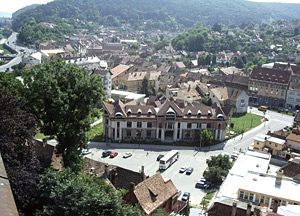
Built by the Saxon colonists living in Transylvania who had to watch over the frontiers of the Hungarian kingdom in the 12th and 13th centuries A.C., the fortress gathered inside its walls Saxon, Romanian and Hungarian craftsmen. That’s the reason why the citadel was named in all the three languages: SCHAESSBURG, SIGHISOARA, and SEGESVAR. More than that, the craftsmen were organized in guilds, each of them administrating a defense tower. The defense walls are 960 meters long, and of the 17 towers there are only nine left, except for the clock tower.
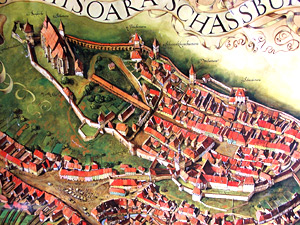
For 15 years, on summer there is organized the three days Medieval Art Festival. It is difficult to present in a few words the multitude of tourist attraction points of this town: towers, bastions, churches and houses. However, the most important are considered to be Turnul cu Ceas (the Clock Tower) – the entrance gate in the citadel – which is also a symbol of Sighisoara, Turnul Cositorarilor (the Tin Coaters Tower), Turnul Macelarilor (the Butcher’s Tower), Turnul Cizmarilor (the Shoemaker’s Tower), Turnul Croitorilor (the Taylor’s Tower), Turnul Cojocarilor (the Furrier’s Tower), Turnul Fierarilor (the Blacksmith’s Tower), Turnul Franghierilor (the Rope Makers’ Tower), Turnul Tabacarilor (the Tanner’s Tower), Biserica Manastirii (the Church of the Monastery), Biserica din Deal (the Church on the Hill), Casa Venetiana (the Venetian House), Casa cu Cerb (the House with Antlers), Casa de pe Stanca (the Cliff House), Casa cu Sindrila (the House with Shingle), Casa Vlad Dracul (the house attributed to Vlad Tepes) and so on.
{banner-sighisoaraen}
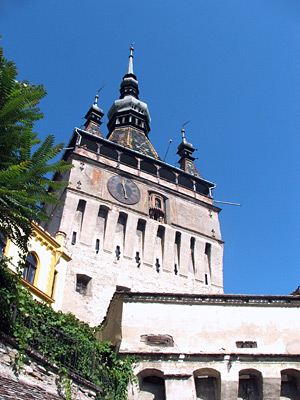
The Clock Tower (Turnul cu ceas)
In the course of time, Turnul Portii (the Gate Tower) was used for the council’s meetings and for storing Sighisoara’s archive and thesaurus. Turnul Portii (the Gate Tower) was named Turnul cu Ceas (the Clock Tower) after 1604, when a clock with a wood mechanism was installed in it. In 1648 the blacksmiths of Sighisoara rebuilt that mechanism using metal components and improved it so that its hands also indicated the minutes. The two faces of the clock are each 2.4 meters in diameter, and one of them looks towards Orasul de Jos, and the other towards the Citadel. The clock was also equipped with two groups of wooden statuettes disposed in three registers. Two of the statuettes represent Justice and Fairness, symbolizing the judicial autonomy of the town. Another statuette represents a brazier announcing the exact time. A “desperate man” is also represented by one statuette, telling the strangers that death penalty is applied in the citadel. After the style of that time, there are also present 0.80 meters tall statuettes made of linden trees, representing the pagan gods personifying the days of the week: Diana, Mars, Mercury, Jupiter, Venus, Saturn and Sun.
In 1964 the clock was equipped with an electric engine. Nowadays, Turnul cu Ceas (the Clock Tower) shelters the History Museum of the town.
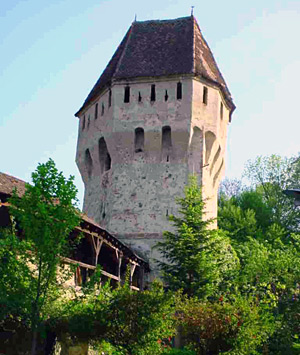
The Tin Coaters Tower (Turnul Cositorarilor)
It is a robust and at the same time strange building, combining a pentagonal drum over a rectangular platform, above which there are the ramparts forming an octagonal floor, and in top of it there is the hexagonal roof, with unequal sides. The mortar, riddled with bullets and cannon balls, gives the impression of a building that went through the heats of many battles. The tower is completed by Galeria Puscasilor (the Gunmen’s Gallery), a sole exemplar in the architecture of the citadel.
The Tanner’s Tower (Turnul Tabacarilor)
Turnul Tabacarilor (the Tanner’s Tower), one of the oldest towers, is situated on the South – East side of the citadel. From the architectonic point of view, it looks like a square prism, with a one slope roof. In 1631, Turnul barbierilor (the Barber’s Tower) was joined to it, but this one was destroyed later.
The Goldsmith’s Tower (Turnul Aurarilor)
Turnul Giuvaergiilor (the Jeweler’s Tower) or Turnul Aurarilor (the Goldsmith’s Tower) is documentary mentioned in 1511, being built on the South – West side of the citadel, next to the Castaldo Bastion, on the highest point of the town. In 1706 it was blown out by kurutzy peasants, in 1809 a thunder destroyed its roof and floor, and by 1863 it became a gymnasium of the Scoala din Deal (the School on the Hill). In 1935 it became a mortuary.
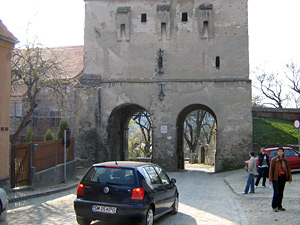
The Taylor’s Tower (Turnul Croitorilor)
Turnul Croitorilor (the Taylor’s Tower) dates from the 14th century, being the second entrance gate in the citadel. The tower belonged to one of the richest guild in the citadel. In 1676 the tower was destroyed by a fire, especially because there were barrels with gun powder and different weapons inside it. Three years later it was rebuilt, and the North – West corridor was turned into a gun powder storehouse.
The Rope Makers’ Tower (Turnul Frangherilor)
Turnul Franghierilor (the Rope Makers’ Tower) is situated on the North – West corner of the upper platform. In 1935, after some archaeological diggings, there were discovered some crenel vestiges, which led to the conclusion that it had been built over an older wall of the citadel. The attendant of the cemetery lived in this tower for a long period of time.
The Butcher’s Tower (Turnul Macelarilor)
Turnul Macelarilor (the Butcher’s Tower) seems to have been built in the 15th century, and then rebuilt in the 16th century. According to documents, it was mentioned for the first time in 1680. It had a great strategic importance, because it was situated at the foot of the steepest portion of the hill that went down from the superior platform to the inferior platform.
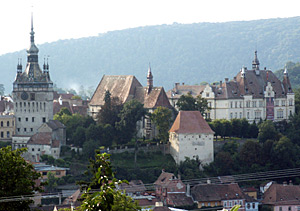
The Blacksmith’s Tower (Turnul Fierarilor)
Turnul Fierarilor (The Blacksmith’s Tower) is a flank tower and was built in 1631 in the place of the old Turnul barbierilor (Barber’s Tower). Its front part has windows and shooting holes that confer it a special aspect. In the past, it protected the Church of the Monastery in the event of sieges.
Unfortunately, in the 19th century some of the buildings were demolished; for instance, Turnul Lacatusilor (the Locksmith’s Tower) and the Franciscan Monastery were pulled down in 1894 to build the Catholic Church; Turnul Dogarilor (the Cooper’s Tower), which was said to be one of the oldest towers of the citadel and whose rooms were used as dwellings, was pulled down in 1886. Turnul Tesatorilor (the Weaver’s Tower) is also known to have housed the military prison of the town, but it was demolished in 1858, and the streets of the citadel were paved for the first time with the resulting stones.
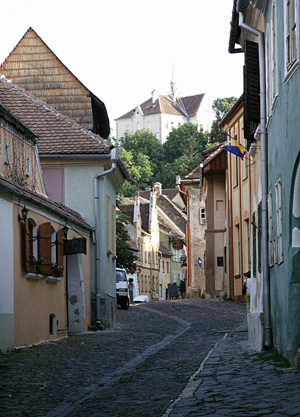
The Furrier’s Tower (Turnul Cojocarilor)
Turnul Cojocarilor (the Furrier’s Tower), built in the 15th century, seems to be the most humble of all, being placed at a small distance from Turnul Macelarilor (the Butcher’s Tower); Poarta Torle (Torle gate), where the sheep were shared in the evening, unifies the two towers.
The Shoemaker’s Tower (Turnul Cizmarilor)
The first documentary attestation of the Turnul Cizmarilor (the Shoemaker’s Tower) dates from 1594, but it was rebuilt under the present shape in 1650. It looks like a hexagonal prism, and it is shorter than the other towers. What is unusual is its small observation tower oriented towards the town. It used to have an artillery bastion in front, but it was demolished in 1846. Nowadays it houses the local radio station called “Radioson”.
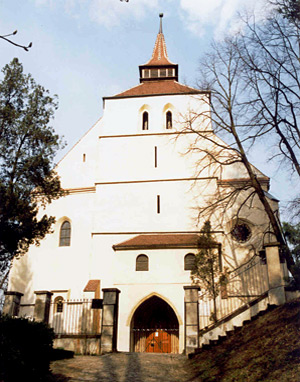
Other tourist attractions in Sighisoara
Biserica din Deal (The Church on the Hill) is the only old crypt Evangelic church in Transylvania, and its walls contain 60 tombstones. Inside the church there is also a collection of altars, brought from Germany, and a collection of bottom drawers. On the walls of the church there is also a fresco dating from 1380 which presents the Holy Trinity as a person with three faces. In the Church of the Monastery there is also a collection of oriental carpets, and an organ concert takes place here every week as well.
Casa Vlad Dracul (Vlad Dracula’s House) is one of the oldest buildings, and it is placed on the left side of the little square in front of the Turnul cu Ceas (Clock Tower). The building was the official residence, belonging to the mayor or to the royal county lord of the citadel. Vlad Dracul, the son of Mircea cel Batran, lived here between 1431 and 1435, as well. Nowadays, the building shelters a restaurant.
Casa cu Cerbi (the House with Antlers), a construction specific  to the Transylvanian Renaissance period, received this name because of a stag head fixed on the angle of the building.
to the Transylvanian Renaissance period, received this name because of a stag head fixed on the angle of the building.
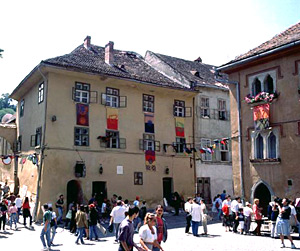
The central square is limited by 18th century houses, inhabited by the noble families of the town. The main fairs or the criminal trials took place in this square, the execution post (pillar of infamy) being placed here as well.
The Bastion Street, on which can be found Casa cu Sindrila (the House with Shingle), a specific handicraftsman’s house, continues the Square. The house shelters the residence of the Interethnic Centre for the Youth, as part of the German Forum of Sighisoara, where they carry on a great number of educational courses for the youth, and it also shelters an Internet-Café.
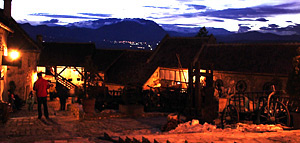
During the Medieval Art Festival, those who move about the streets of the fortress, artists, keepsake vendors, or even tourists, generally wear clothes reminding of the Feudal period. In 2007, the local authorities launched the “S.O.S. the Citadel of Sighisoara” campaign, trying to aware the Government of the defacement of monuments.
{tours-banner-scroll}
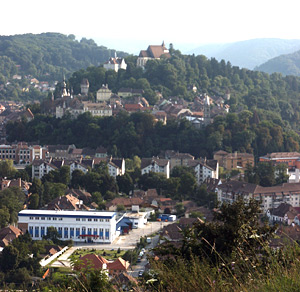
Included in the UNESCO patrimony
In 1999 Sighisoara was included in the UNESCO patrimony, beeing, together with other European cities with the same type of monuments, on the World Heritage Cities list of protected monuments as well.
How to get there and accommodation possibilities
Situated at about 279 km far from Bucharest and 117 km from Brasov, Sighisoara attracts a lot of foreign tourists every year. One can get here by car on the E 60 European Highway, from Targu Mures to Brasov, or by train, on the Bucharest – Brasov – Teius route, with shuntings to Arad and Oradea. The accomodation possibilities are unlimited, in hotels, motels and boarding houses.
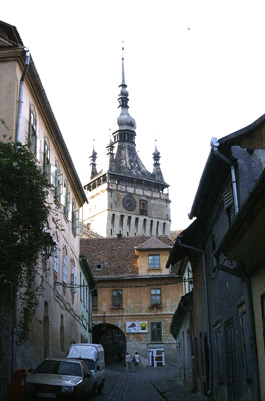
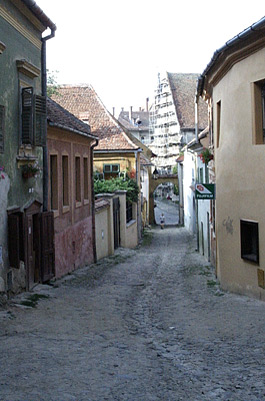
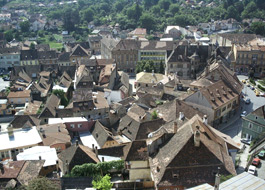
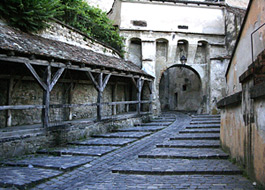
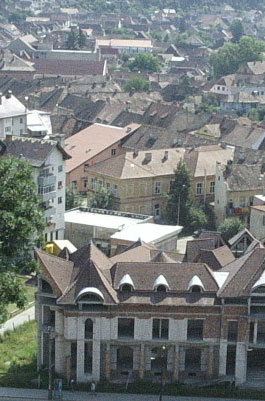
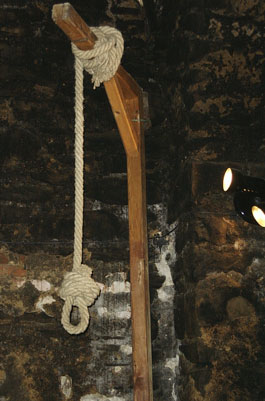
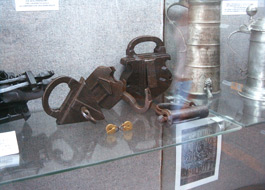
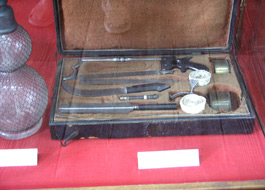
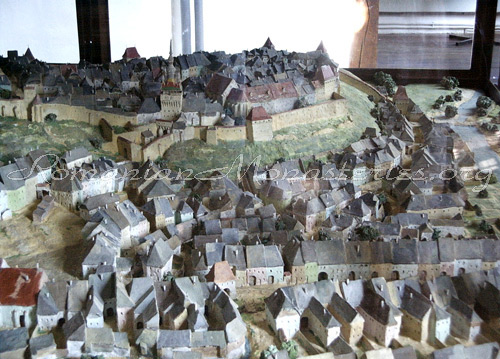
{adsgoogle300}









